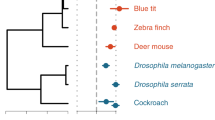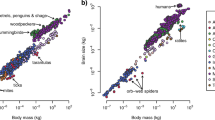Abstract
Many comparative physiological studies aim to determine if a particular species differs from a prediction based on a linear allometric regression for other species. However, the judgment as to whether the species in question conforms to this allometric relationship is often not based on any formal statistical analysis. An appropriate statistical method is to compare the new species’ value with the 95% confidence limits for predicting an additional datum from the relationship for the other species. We examine the basal metabolic rate (BMR) of the termitivorous numbat (Myrmecobius fasciatus) and aardwolf (Proteles cristatus) to demonstrate the use of the 95% prediction limits to determine statistically if they have a lower-than-expected BMR compared to related species. The numbat’s BMR was 83.6% of expected from mass, but fell inside the 95% prediction limits for a further datum; a BMR < 72.5% of predicted was required to fall below the one-tail 95% prediction limits. The aardwolf had a BMR that was only 74.2% of predicted from the allometric equation, but it also fell well within the 95% prediction limits; a BMR of only 41.8% of predicted was necessary to fall below the one-tail 95% prediction limits. We conclude that a formal statistical approach is essential, although it is difficult to demonstrate that a single species statistically differs from a regression relationship for other species.


Similar content being viewed by others
Abbreviations
- BMR:
-
Basal metabolic rate
- C:
-
Thermal conductance
- EWL:
-
Evaporative water loss
- FMR:
-
Field metabolic rate
- MMR:
-
Maximum metabolic rate
- RMR:
-
Resting metabolic rate
- \(\bar{{X}}\) :
-
Mean X
- \(\hat{{Y}}\) :
-
Predicted Y value
- ∑x 2 :
-
Corrected sum of squares for X
- s Y·X :
-
Standard error of estimate for Y
- \({s}_{\hat{Y}}\) :
-
Standard error of predicted Y
References
Abensperg-Traun MA, Dickman CR, DeBoer ES (1991) Patch use and prey defence in a mammalian myrmecophage the echidna Tachyglossus aculeatus (Monotremata Tachygossidae): a test of foraging efficiency in captive and free-ranging animals. J Zool 225:481–494
Anava A, Kam M, Shkolnik A, Degen AA (2001) Heat production and body temperature of Arabian babblers (Turdoides squamiceps): a bird from hot desert habitats. J Arid Environ 48:59–67
Anderson MD, Richardson PRK, Woodall PF (1992) Functional analysis of the feeding apparatus and digestive tract anatomy of the aardwolf Proteles cristatus. J Zool 228:423–434
Anderson MD, Williams JB, Richardson PRK (1997) Laboratory metabolism and evaporative water loss of the aardwolf, Proteles cristatus. Physiol Zool 70:464–469
Archer M (1984) The Australian marsupial radiation. In: Archer M, Clayton G (eds) Vertebrate zoogeography and evolution in Australasia (animals in space and time). Hesperian Press, Carlisle, pp 633–808
Archer M, Kirsch JAW (1977) The case for the Thylacomyidae and Myrmecobiidae, Gill, 1972, or why are marsupial families so extended? Proc Linn Soc N S W 102:18–25
Aschoff J (1981) Thermal conductance in mammals and birds: its dependence on body size and circadian phase. Comp Biochem Physiol 69A:611–619
Aschoff J, Pohl H (1970) Rhythmic variations in energy metabolism. Fed Proc 29:1541–1552
Baudinette RV, Churchill SK, Christian KA, Nelson JE, Hudson PJ (2000) Energy, water balance and the roost microenvironment in three Australia cave-dwelling bats (Microchiroptera). J Comp Physiol 170:439–446
Baverstock PR, Krig M, Birrell J (1990) Evolutionary relationships of Australian marsupials as assessed by albumin immunology. Aust J Zool 37:273–288
Bininda-Emonds ORP, Gittleman JL, Purvis A (1999) Building large trees by combining phylogenetic information: a complete phylogeny of the extant Carnivora (Mammalia). Biol Rev 74:143–175
Bonaccorso FJ, McNab BK (2003) Standard energetics of leaf-nosed bats (Hipposieridae): its relationship to intermittent- and protracted-foraging tactics in bats and birds. J Comp Physiol B 173:43–53
Bozinovic F, Ruiz G, Rosenmann M (2004) Energetics and torpor of a South American “living fossil”, the microbiotheriid Dromiciops gliroides. J Comp Physiol B 174:293–297
Bradley SR, Deavers DR (1980) A re-examination of the relationship between thermal conductance and body weight in mammals. Comp Biochem Physiol 65A:465–476
Burton CT, Weathers WW (2003) Energetics and thermoregulation of the Gouldian finch (Erythrura gouldiae). Emu 103:1–10
Cheverud JM, Dow MM (1985) An autocorrelation analysis of genetic variation due to lineal fission in social groups of Rhesus macaques. Am J Physiol Anthropol 67:113–121
Cooper CE, Withers PC (2002) Metabolic physiology of the numbat (Myrmecobius fasciatus). J Comp Physiol B 172:669–675
Cooper CE, Withers PC (2003) Field metabolic rate and water turnover of the numbat (Myrmecobius facsiatus). J Comp Physiol B 173:687–693
Cortes A, Tirado C, Rosenmann M (2003) Energy metabolism and thermoregulation in Chinchilla revicaudata. J Thermal Biol 28:89–495
Crawford EC, Lasiewski RC (1968) Oxygen consumption and respiratory evaporation in the emu and rhea. Condor 70:333–339
Draper NR, Smith H (1998) Applied regression analysis. Wiley, New York
Garland T, Adolph SC (1994) Why not to do two-species comparative studies: limitations on inferring adaptation. Physiol Zool 67:797–828
Garland T, Ives AR (2000) Using the past to predict the present: confidence intervals for regression equations in phylogentic comparative methods. Am Nat 155:346–364
Geiser F, Brigham RM (2000) Torpor, thermal biology and energetics in Australian long-eared bats (Nyctophilus). J Comp Physiol B 170:153–162
Hayssen V, Lacy RC (1985) Basal metabolic rates in mammals: taxonomic differences in the allometry of BMR and body mass. Comp Biochem Physiol A 81:741–754
Hinds DS, MacMillen RE (1985) Scaling of energy metabolism and evaporative water loss in heteromyid rodents. Physiol Zool 58:282–298
Hinds DS, MacMillen RE (1986) Scaling of evaporative water loss in marsupials. Physiol Zool 59:1–9
Kalin N, Martin RD, Genoud M (2003) Basal rate of metabolism and temperature eregulation in Goeldi’s monkey (Callimico goeldii). Comp Biochem Physiol A 135:279–290
Kirsch JAW (1968) Prodromus of the comparative serology of Marsupialia. Nature 217:418–420
Kirsch JAW, Palma RE (1995) DNA/DNA hybridisation studies of carnivorous marsupials. V. A further estimate of relationships among opossums (Marsupialia: Didelphidae). Mammalia 59:403–425
Kirsch JAW, Lapointe FJ, Springer MS (1997) DNA-hybridisation studies of marsupials and their implications for metatherian classification. Aust J Zool 45:211–280
Klaassen M, Agrell J, Lindstrom A (2002) Metabolic rate and thermal conductance of lemmings from high-arctic Canada and Siberia. J Comp Physiol B 172:371–378
Kleiber M. (1932) Body size and animal metabolism. Hilgardia 6:315–353
Lindstrom A, Klaassen M (2003) High basal metabolic rates of shorebirds while in the arctic: a circumpolar view. Condor 105:420–427
Lovegrove BG (2000) The zoogeography of mammalian basal metabolic rate. Am Nat 156:201–219
Lovegrove BG (2001) The evolution of body armor in mammals: plantigrade constraints of large body size. Evolution 55:1464–1473
Lovegrove BG, Smith GA (2003) Is ‘nocturnal hypothermia’ a valid physiological concept in small birds? A study on Bronze Mannikins Spermestes cucullatus. Ibis 145:547–557
Mathias ML, Nunes AC, Marques CC, Sousa I, Ramalhinho MG, Aufray JC, Catalan J, Britton-Davidian J (2004) Adaptive energetics in house mice, Mus musculus domesticus, from the island of Porto Santo (Madeira archipelago, North Atlantic). Comp Biochem Physiol A 137:703–709
McKechnie AE, Lovegrove BG (2003) Faculative hypothermic responses in an Afrotripical arid-zone passerine, the red-headed finch (Amadina erythrocephala). J Comp Physiol B 173:339–346
McNab BK (1984) Physiological convergence amongst ant-eating and termite-eating mammals. J Zool 203:485–510
McNab BK (1988) Complications inherent in scaling basal rate of metabolism in mammals. Quat Rev Biol 63:25–54
McNab BK (2000) The standard energetics of mammalian carnivores: Felidae and Hyaenidae. Can J Zool 78:2227–2239
McNab BK, Bonaccorso FJ (2001) The metabolism of New Guinean pteropidid bats. J Comp Physiol B 171:201–214
Merola-Zwartjues M, Ligon JD (2000) Ecological energetics of the Puerto Rican tody: heterothermy, torpor and intra-island variation. Ecology 81:990–1003
Montgomery DC, Peck EA (1982) Introduction to linear analysis. Wiley, New York
Myers RH (1986) Classical and modern regression with applications. Duxbury Press, Boston
Nagy KA (1987) Field metabolic rate and food requirement scaling in mammals and birds. Ecol Monogr 57:111–128
Nagy KA (1994) Field bioenergetics of mammals: what determines field metabolic rates? Aust J Zool 42:43–53
Nagy KA, Girard IA, Brown TK (1999) Energetics of free-ranging mammals, reptiles and birds. Annu Rev Nutr 19:247–277
Neter J, Wasserman W, Kutner MH (1990) Applied linear statistical models: regression, analysis of variance, and experimental design. Irwin, Boston
Peinke DM, Brown CR (2003) Metabolism and thermoregulation in the springhare (Pedetes capensis). J Comp Physiol B 173:347–353
Redford KH, Dorea JG (1984) The nutritional value of invertebrates with emphasis on ants and termites as food for mammals. J Zool 203:385–395
Reynolds PS, Lee RM (1996) Phylogenetic analysis of avian energetics: passerines and nonpasserines do not differ. Am Nat 147:735–759
Schleucher E (2002) Metabolism, body temperature and thermal conductance of fruit-doves (Aves: Columbidae, Treroninae). Comp Biochem Physiol A 131:417–428
Schleucher E, Withers PC (2001) Re-evaluation of the allometry of wet thermal conductance for birds. Comp Biochem Physiol A 129:821–827
Song Z, Wang D (2003) Metabolism and thermoregulate in the striped hamster Cricetulus barabensis. J Thermal Biol 28:509–514
Weathers WW, Gerhart KL, Hodum PJ (2000) Thermoregulation in Antarctic fulmarine petrels. J Comp Physiol B 170:561–572
White CR, Seymour RS (2003) Mammalian basal metabolic rate is proportional to body mass. Proc Natl Acad Sci USA 100:4046–4049
Williams JB (1996) A phylogenetic perspective of evaporative water loss in birds. Auk 113:457–472
Williams JB (2001) Energy expenditure and water flux of free-living Dune Larks in the Namib: a test of the reallocation hypothesis on a desert bird. Funct Ecol 15:175–185
Williams TM, Haun J, Davis RW, Fuiman LA, Kohin S (2001) A killer appetite: metabolic consequences of carnivory in marine mammals. Comp Biochem Physiol A 129:785–796
Williams JB, Munoz-Garcia A, Ostrowski S, Tieleman BI (2004) A phylogenetic analysis of basal metabolism, total evaporative water loss, and life-history among foxes from desert and mesic regions. J Comp Physiol B 174:29–39
Withers PC, Thompson GG, Seymour RS (2000) Metabolic physiology of the north-western marsupial mole, Notoryctes caurinus (Marsupialia: Notorycidae). Aust J Zool 48:241–258
Withers PC, Cooper CE, Larcombe AN (2006) Environmental correlates of physiological variables in marsupials. Physiol Biochem Zool (in press)
Zar JH (1999) Biostatistical analysis. Prentice-Hall, Englewood Cliffs
Author information
Authors and Affiliations
Corresponding author
Additional information
Communicated by I.D. Hume
Rights and permissions
About this article
Cite this article
Cooper, C.E., Withers, P.C. Numbats and aardwolves—how low is low? A re-affirmation of the need for statistical rigour in evaluating regression predictions. J Comp Physiol B 176, 623–629 (2006). https://doi.org/10.1007/s00360-006-0085-8
Received:
Revised:
Accepted:
Published:
Issue Date:
DOI: https://doi.org/10.1007/s00360-006-0085-8




